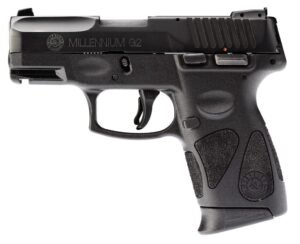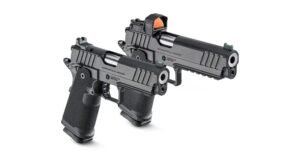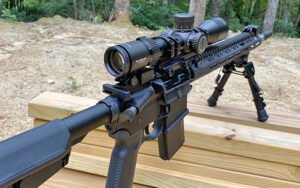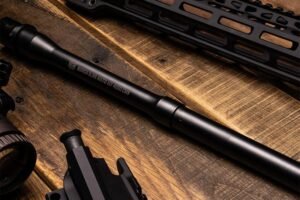Taurus G2C Review: Amazing Value or Too Good to be True?

Taurus G2C Review
The Taurus PT-111 G2 has undergone a few minimal internal improvements and cosmetic changes and released back into the wild as the Taurus G2C.
With many retailers offering this subcompact for around the $200 mark, it’s certainly turning a lot of heads and getting a lot of interest. Of course, one of the most asked questions is: “Is the Taurus G2C any good?”, or “Why is the Tauris G2C so cheap?”
So what’s the scoop? Did Taurus create a dirt-cheap concealed carry wonder-gun, or is this a case of getting what you pay for? It’s probably no surprise that it’s actually a bit of both.
But first, let’s get the particulars out of the way. The G2C is a polymer-framed, striker-fired, double action-only semiautomatic subcompact pistol. With its double stack magazine it has a 12+1 capacity. It features a 3.2 inch barrel, with an overall length of 6.24 inches, and tips the scales at 22 oz. It’s available in 9mm only. It has standard three-dot sights with adjustable rear.
What’s it Like?
Looks aren’t everything, but good design doesn’t hurt. Beauty is in the eye of the beholder, and as Glock’s success would indicate, not a crucial factor to buyers. But most seem to agree that this is a very nice looking gun from a shape and contour standpoint.
The big that thing the G2C has going for it is that it’s a subcompact with a double-stack configuration. At 12+1 rounds, you’re getting into regular compact-sized gun capacity territory – better than many other double stack subcompacts. Like someone once said, bullets are options; the more you have, the better. Of course, the trade-off is that it’s a little beefier than most single stack subcompacts, but it’s still quite concealable for most. This is a big deal, especially for anyone that prefers to open carry, but wants to keep things minimal. You get a lot of 9mm rounds for such a small package.
With a larger magazine, the grip fills the palm nicely and allows for a sturdier grasp compared to many single-stack models. Combined with contouring and aggressive texturing, the G2C is easy and comfortable to hold onto.
Safety-wise, the G2C features a manual safety lever and trigger safety, as well as a loaded chamber indicator. A single picatinny rail slot allows the user to mount a light or laser if desired. That’s quite a few features for a sub $200 pistol.
But How Does the Taurus G2C Shoot?
At the end of the day, performance and reliability trumps all else. So how did it do? Out of the box, not great, admittedly. A quick way to judge the ability and overall reliability of a new firearm is to start fresh testing with the cheapest ammo we have, and the Taurus G2C just wasn’t up to the task. After ensuring proper lubrication and starting with some low-cost 115gr FMJ factory reloads, we experienced several failures per magazine. For comparison, new “higher-end” firearms from Glock, Sig, Walther, etc. have no issues with this same ammo. In almost every instance, the empty case failed to fully extract from the G2C’s breach, causing the next round to jam up against the half-protruding empty case.
After switching to something a bit better – Fiocchi 115 gr FMJ, things improved, but we were still experiencing an unacceptable number of failures. Happily, the G2C functioned flawlessly the minute we started using high-quality defense ammo. After going back to more of the Fiocchi FMJs, the previous failures were less frequent. From there, going back to shooting the original cheap reloads, we started seeing problems again. So this tells us two things: The G2C works much more reliably after a bit of a break-in period, and it doesn’t like cheap brass.
Obviously any manufacturer can put out a lemon once in a while, so maybe that the case for our test subject. We’ve informally polled many of our customers who’ve purchased the G2C, and most relate a similar opinion: the Taurus G2C really functions noticeably better with high quality ammo. This isn’t that strange. For many firearms, especially lower cost ones where the fit and finish of the manufacturing process can be less intense, the quality of ammo can make a big difference in how reliably it cycles.
Otherwise, the G2C is relatively pleasant to shoot, considering it’s compact size. Recoil is fairly tame, and while the first pull is long due to its double action configuration, the trigger was found to be surprisingly smooth with a decently clean break. It’s no Walther PPQ, but for a $200 pistol out of the box, there are no complaints to be had. Accuracy was adequate for a concealed carry handgun; at 10 yards we had no problem putting holes in what we were aiming at.
Final Thoughts?
So what’s the verdict? It’s all about perspective. If you’re expecting high-end quality and reliability out of the box, that’s just not realistic. There’s a reason the Taurus G2C is inexpensive. Time is money for any manufacturer, so fit, finish and attention to detail are elements that can suffer in an effort to keep costs down. We would venture to guess that the odds of getting a lemon are higher with a $200 handgun. The Taurus G2C definitely cycled more reliably (after a break-in period) with premium ammo (which it should), but obviously that means you won’t be getting a cheap range plinker.
We won’t sugar-coat it; there are probably better choices if you’re planning to only own one handgun, or are looking for an everyday carry gun to practice regularly with. In our opinion the Glock G26, the SIG P320 subcompact, H&K’s VP9SK, the FN FNS 9C , Walther’s PPQ SC or the Smith & Wesson M&P 9C are all better choices in the double-stack subcompact market. Of course they all come with a substantial price increase. So is it better to spend $400-$500 on a gun and have it be reliable out of the box, or buy a $200 gun and then potentially spend another $200 in ammo to get it functioning reliably? You tell me.
But if you’re on a limited budget and just need an extreme backup option – something small that you can stash away in an emergency bag so you have one less thing to remember to grab on your way out – it would make a fine option that won’t empty your bank account. As long as you’ve put it through a short break-in period and you’re loading it with good defense ammo, the G2C should perform when you need it.
Springfield Armory Prodigy Review
The Springfield Armory Prodigy takes the proven 1911 platform and enhances it with double-stack capacity and a performance-driven feature set.
What is a RECCE Rifle? Meet the Longshot
US Navy Seals developed today’s Recce Rifle concept in the early 90s to bridge the tactical gap between their CQB M4s, and their larger and heavier precision rifles.
Smith & Wesson CSX Review
Smith & Wesson’s CSX joins the market of similar high capacity micro 9s while standing out from the crowd with features and flourishes not found on many competitors.
5.56 NATO VS .223 WYLDE
People new to the AR-15 can be forgiven for believing that they’re only made to fire the 5.56 NATO cartridge – the same that militaries around the world use (the NATO designation is there for a reason). They’ve also likely heard that for all intents and purposes, the 5.56 NATO and .223 Remington cartridges are pretty much…
AR-15 Pistol vs SBR. What’s the difference?
The laws that determine what takes an AR-15 from a pistol or rifle into NFA territory can be both fascinating and headache-inducing. But by keeping few rules of thumb in mind, it’s not as bad as it might seem.






